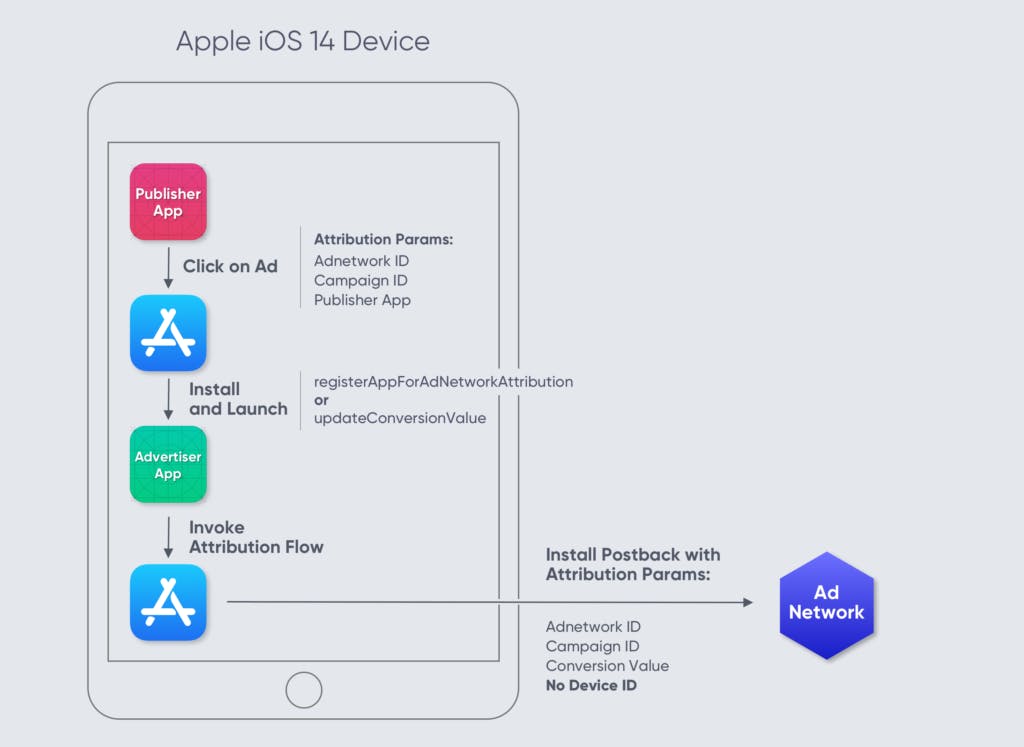2020-12-10
Apple iOS 14 IDFA update
What is Apple’s IDFA Update?
Apple has recently released an update to the iOS mobile operating system by upgrading users to iOS 14. This comes with a large focus on user privacy, effectively changing the way that apps natively track users. Apple has, however, delayed the privacy feature aspect of the iOS 14 update until 2021. This is to allow advertisers to adapt to the changes prior to rollout.
Given the numerous changes to browsers over the last few months / years with ETP (Enhanced Tracking Prevention) in Mozilla Firefox, Intelligent Tracking Prevention (ITP) in Safari and Google announcing the deprecation of the 3rd party cookie in Chrome, it was not unexpected that this would move to native apps, too.
Current state of tracking
To relay the upcoming changes, it’s important to first understand how apps currently track users – Apple devices deploy a tracking ID named IDFA (Identifier for Advertisers) by default. This ID is unique to an individual device and is the same as holding a personal consistent ID that allows Mobile Measurement Partners (MMPs) and other platforms to utilize this ID as a way of tracking respective behaviors from both an attribution and in-app perspective, allowing a business to optimize media performance and make better decisions based on in-app behaviors and purchases.
User consent
The first major change is that apps will require consent from a user before the IDFA is exposed to the app SDK (Software Development Kit). This opt-in is compulsory and will be implemented via Apple’s App Tracking Transparency Framework (ATT).
More information on ATT can be found here. This will be compulsory for apps using iOS 14. It’s hard to estimate what the opt-in rate will be, but speculation suggests that it will be relatively low.
A new measurement framework
The second major change is that Apple will be utilizing a new measurement / reporting framework named SKAdNetwork for preserving privacy on mobile, yet still providing media performance reporting. SKAdNetwork works by having the mobile operating system become a privacy-oriented mediator between the publisher (the app where the ad is shown), the advertiser (a different app being advertised) and the ad network (that places the ad in the first place).
The aim of this framework is to provide anonymous insight back to advertising networks that are driving app installs. This allows advertisers to attribute conversions and gauge media performance, albeit at a significantly less granular level than previously.

Image from Singular.
More information regarding SKAdNetwork can be found here.
Both of these changes further deepen the importance of a strong device graph from platforms such as Google, Facebook, etc. With Facebook confirming they will not be collecting IDFA and only utilizing the SKAdNetwork, they will be reliant on server-side matching to adequately target users, hence most platforms will rely more heavily on advanced matching solutions to enrich their device graph.
How does this affect me?
This comes with a few significant changes, primarily that the targeting capabilities of advertising networks (e.g. Facebook Audience Network) will suffer as it’s not possible to identify a single user (unless they’ve opted in to share IDFA). As a byproduct, ads will likely become less personal, and whilst reporting will still be provided, it will be at an aggregate level via the SKAdNetwork.
In addition, due to the lack of granularity in data from the SKAdNetwork, this will open a few challenges, such as no real ROI or LTV calculations provided. As it’s primarily installs being measured, there is at least a 24-hour postback delay, and as data is reported by networks, there is likely to be a lower level of trust from advertisers.
However, similar to what we’d seen when Apple enabled ITP on Safari, as brands adapt to the changes with targeting and reporting, media CPMs will often decline, leaving an opportunity to capitalise on cheaper media, particularly with Apple Search Ads.
Mobile apps that rely on Deferred Deep-Linking will be affected. Apple is yet to provide an official method for implementing Deferred Deep Links such passing parameters through the App Store and being able to retrieve these after the App is installed. iOS 14 currently only supports “Universal Links” and these continue to work as expected. However, Universal Links only work for users that already have the app installed. For users that don’t have the app installed, a Deferred Deep Link is common.
MMPs such as AppsFlyer and Adjust are affected to a lesser degree since they also utilise additional methods like their own user-graph database, fingerprinting, cookie-sharing and other methods (that are also expected to be deprecated over time). Therefore, MMPs Deferred deep links are also affected.
What do I need to do?
After reviewing a number of Google Analytics 360 accounts, we’d noted that iOS 14 had around 35% install rate within the first week of release. However, Apple has delayed the privacy changes until the start of 2021 to give app developers and websites more time to adapt their services. More information here.
Here are a few suggestions:
We advise that by the end of 2020, you update your SDKs to iOS 14 as soon as they’re available and also integrate ATT within your app for consent to be compliant. It’s important to ensure that the SDKs are only called after ATT has fired.
If you are currently using an MMP such as Appsflyer, they will still collect IDFAs if the user opts into tracking. For users who opt-out, they will go down the SKAdNetwork data flow. More information on Appsflyer and iOS 14 can be found here.
From a match rate perspective, it’s beneficial to enrich Facebook’s device graph by leveraging advanced matching solutions (e.g. via pixel or server-to-server). This will involve utilizing URL pass-backs pre identification and also sharing encrypted personally identified information (PII) when a user self-identifies, for example, via registration or login. This is applicable for both web and native app.
Given that data sharing opt-in will take an expected decline, similar to how we’re advising clients to adapt with web-based tracking tools (e.g. GA360), shift your analysis mindset from precision to prediction. This will mean extrapolating insights from a smaller, yet more accurate data set. This is critically important given the lack of granularity from the SKAdNetwork.
From a reporting perspective, to receive the most insightful data back, you’ll need to rely on the campaign names and SKAdNetwork postback set up to get as much insightful data back as possible. To provide the most granular reporting, it’s highly advised to have a single ad-set and creative is used per campaign name. This avoids confusion when multiple creative is being utilized.
In addition, one key strategy that we’re advising brands is to strengthen relationships with customers to warrant the sharing of data. Historically, data sharing was considered business as usual, but with the industry changes, it’s a commodity. Seek ways to increase opt-ins and model data based on previous patterns.
Embrace change
Finally, it’s important to recognize that these changes are beneficial within the industry as a way to preserve the privacy of users. The aim here is not to try and find hacks and workarounds (e.g. fingerprinting), but instead, adapt accordingly. Brands that embrace change will be the ones that succeed going forward.
